Charles E W Bean, Diaries, AWM38 3DRL 606/271/1 - 1917 - 1938 - Part 4
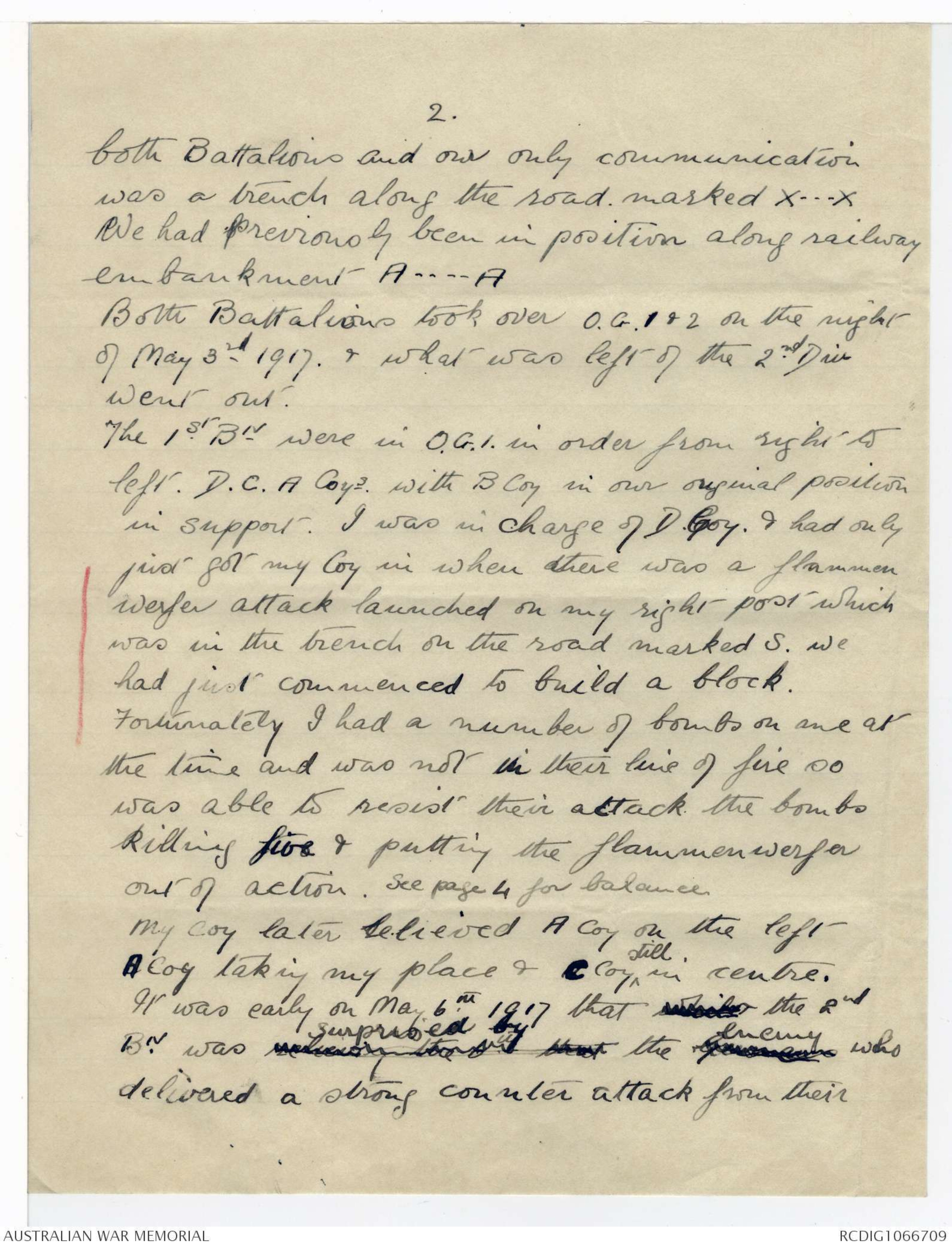
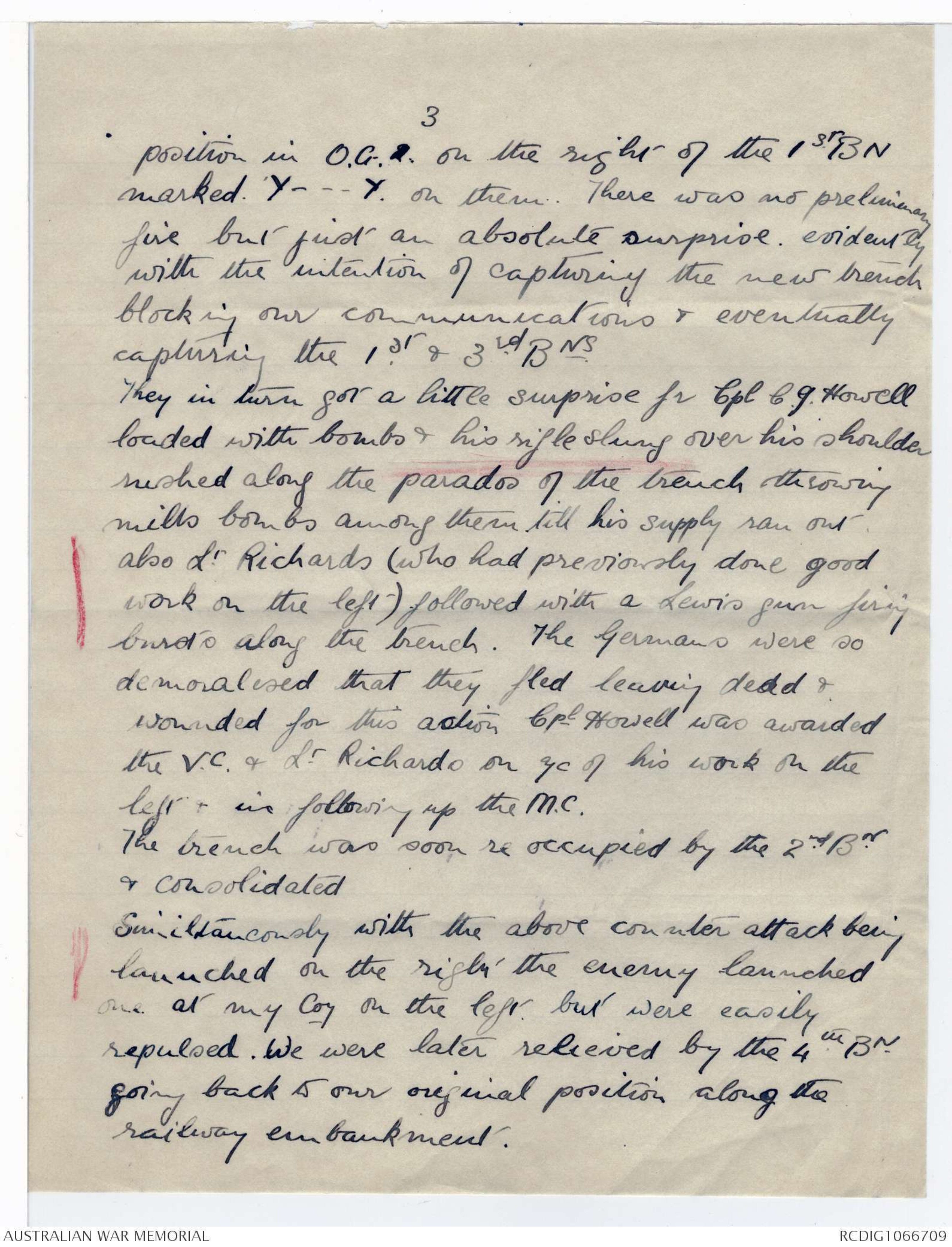
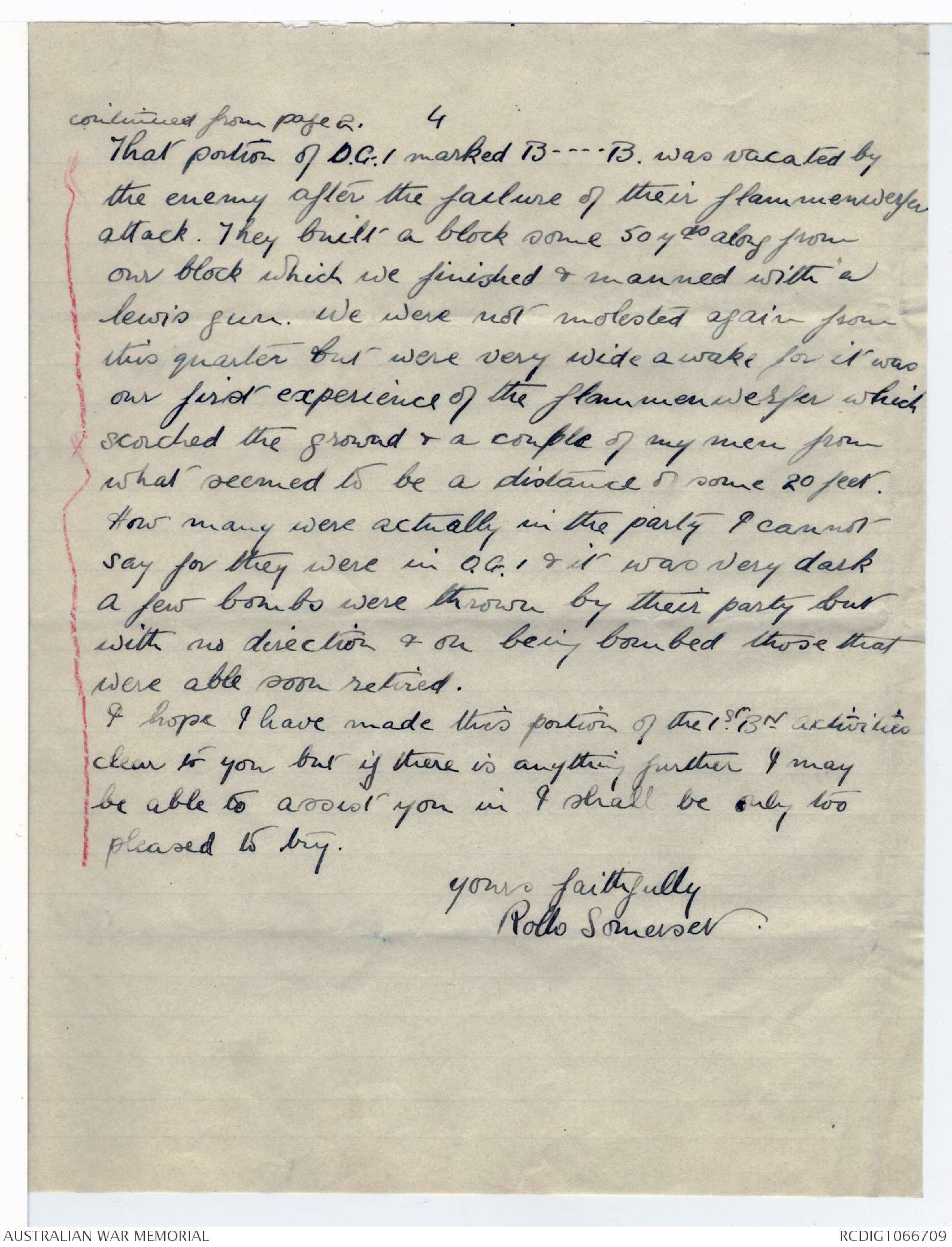

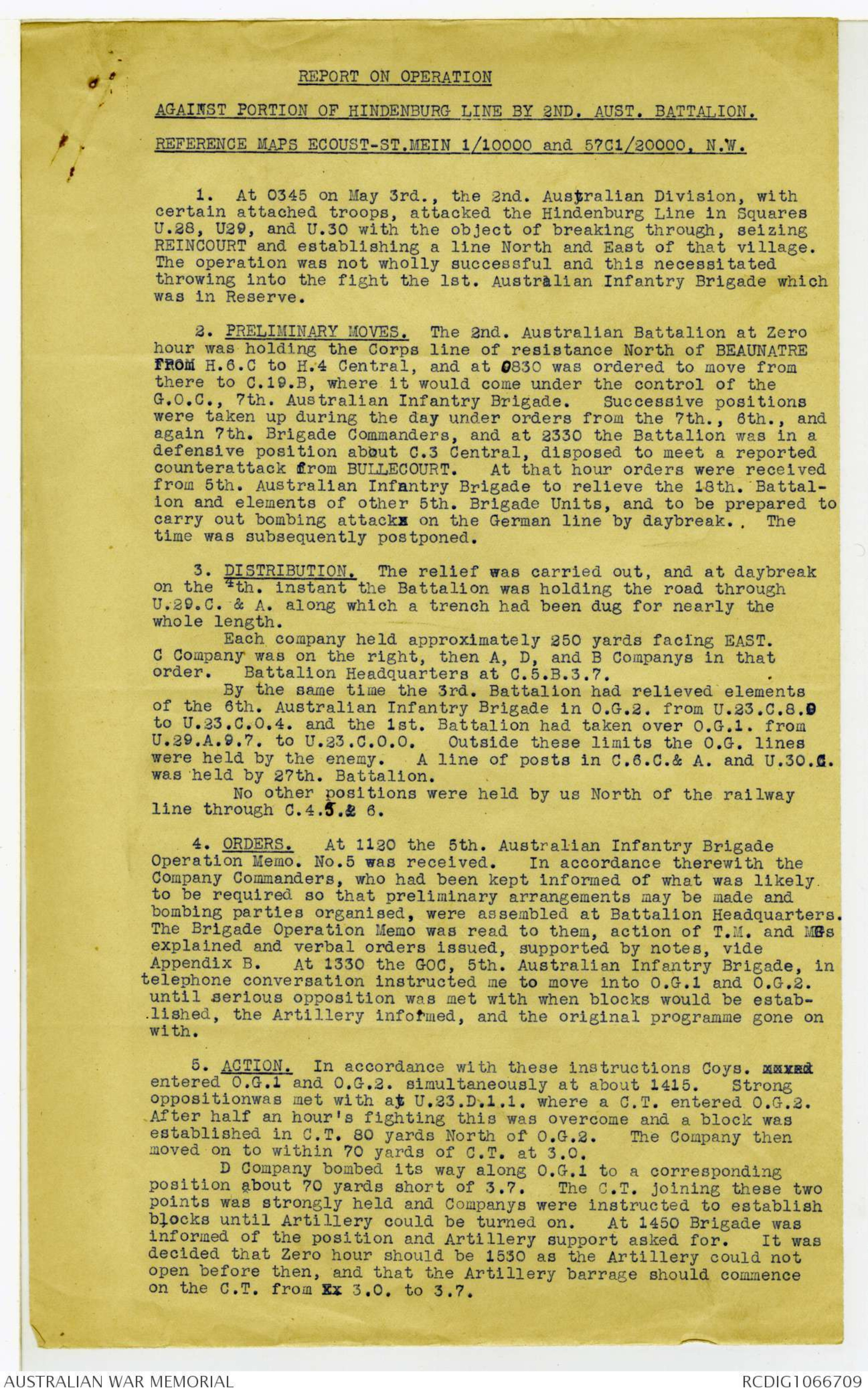
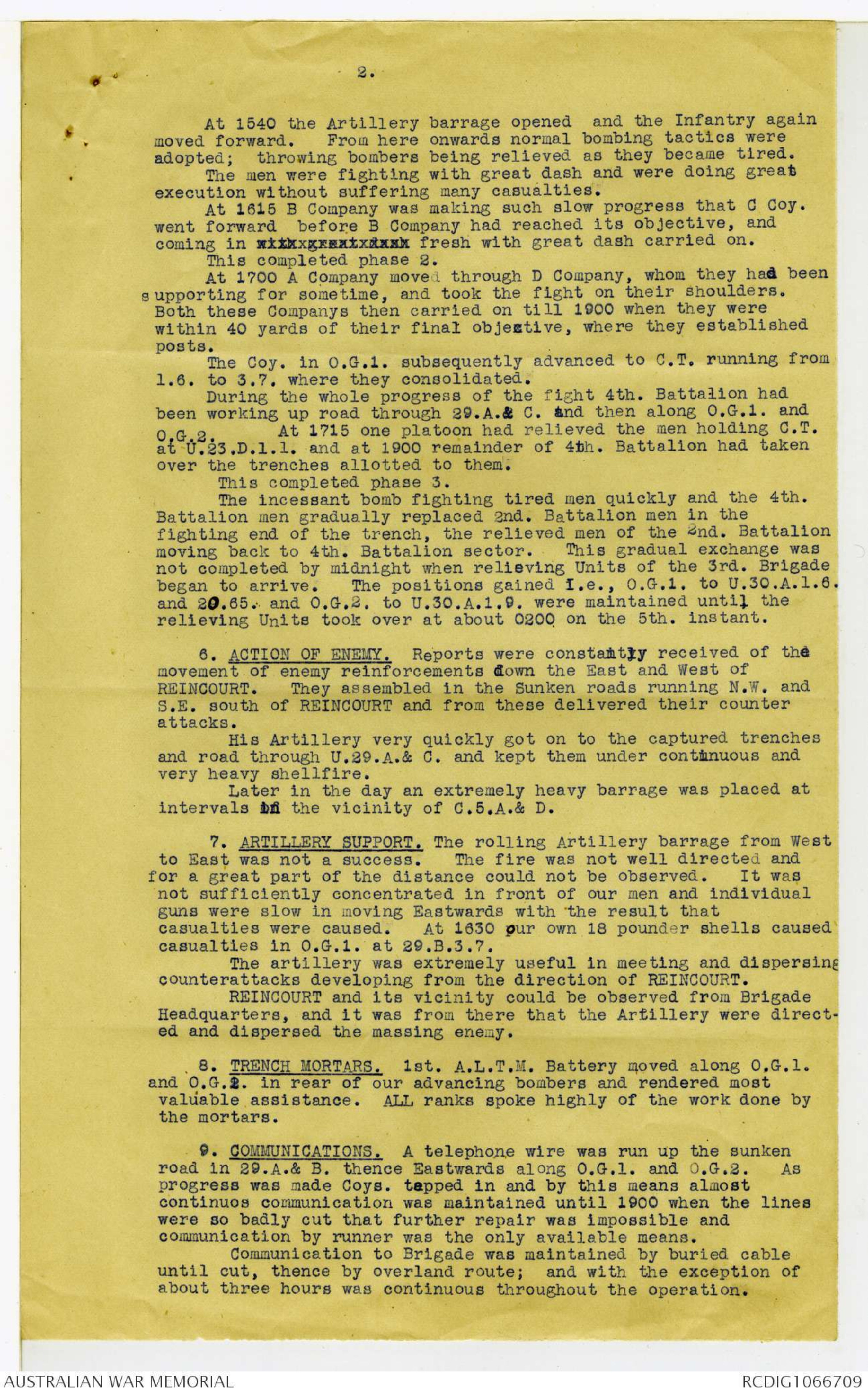
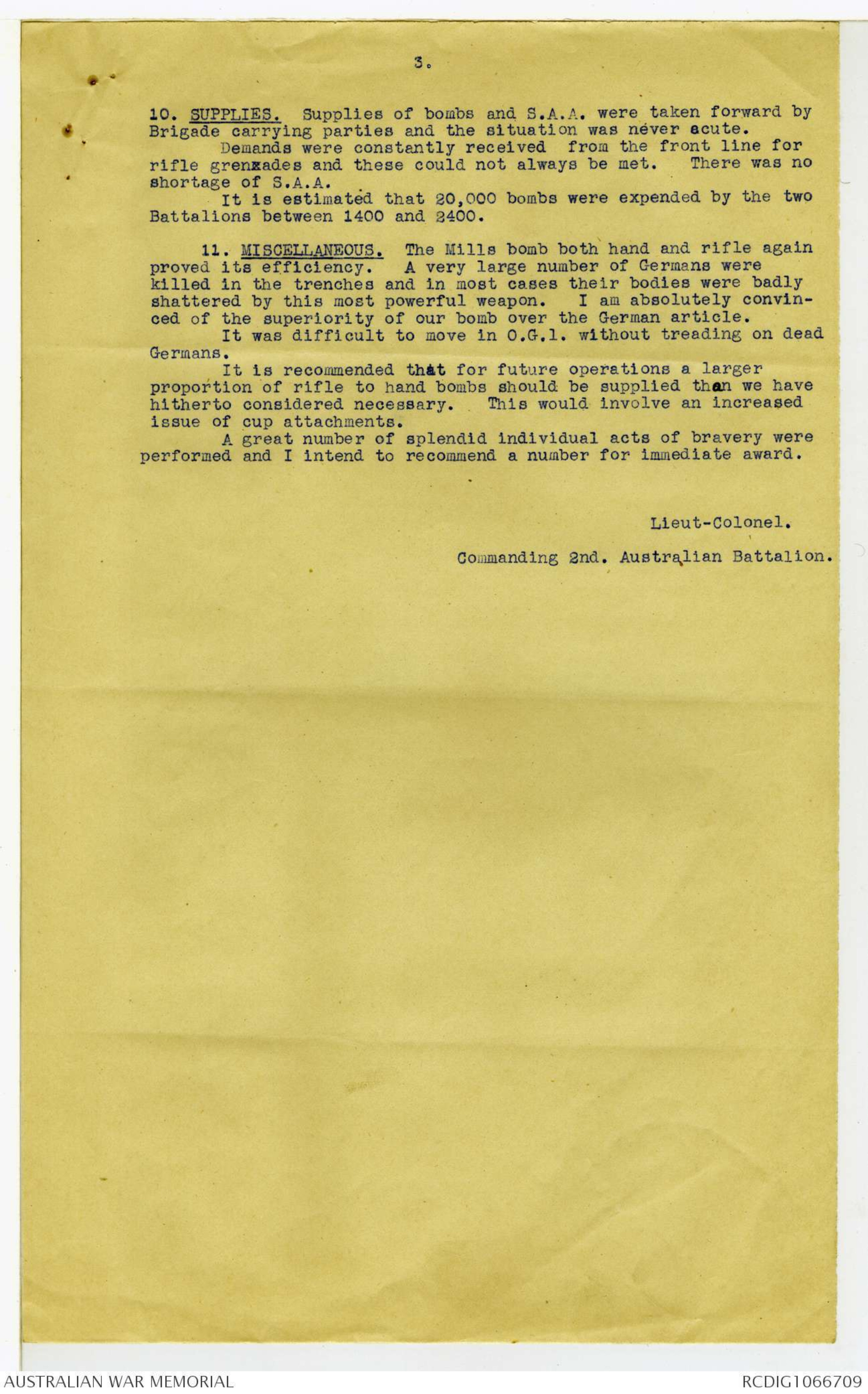
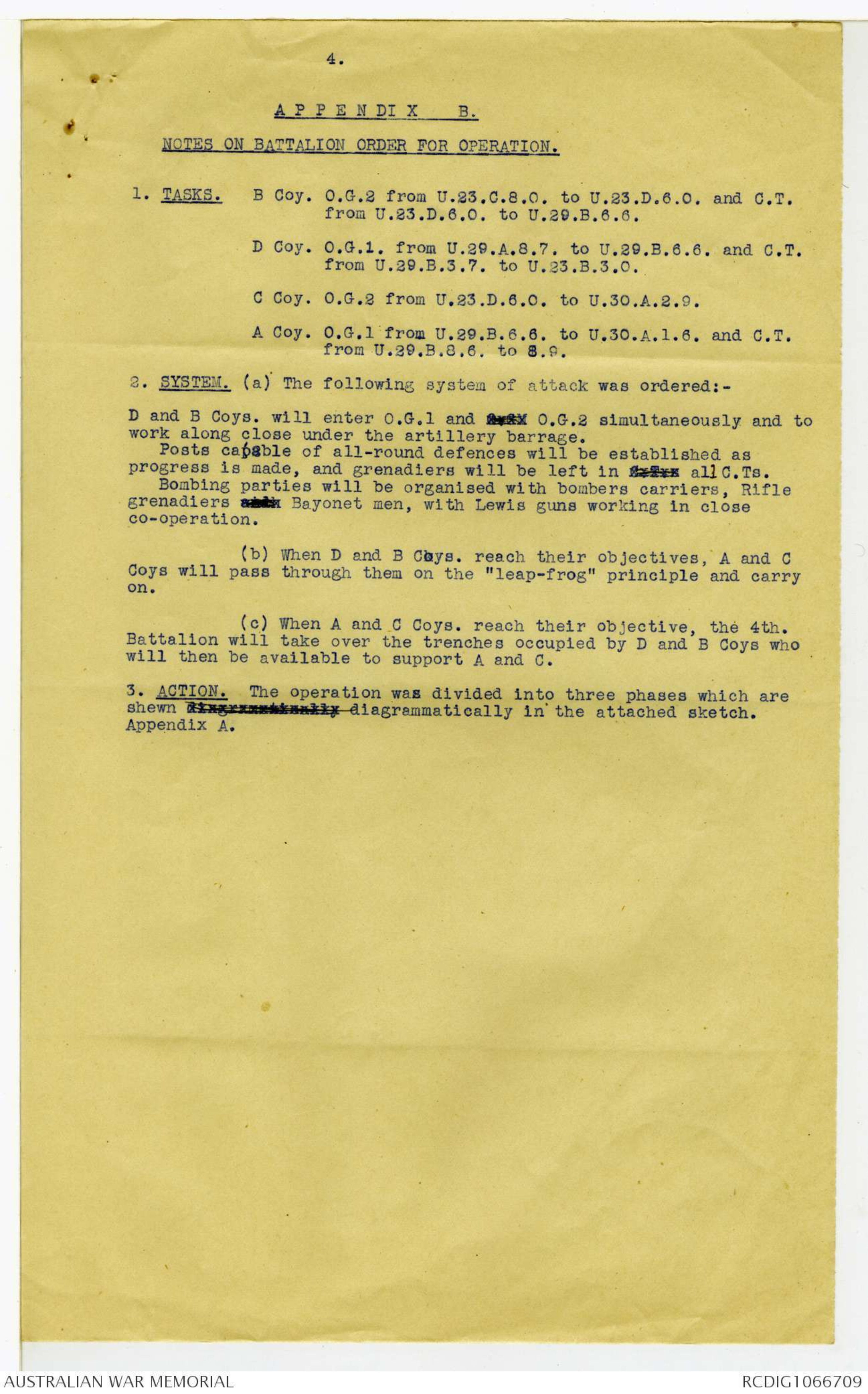
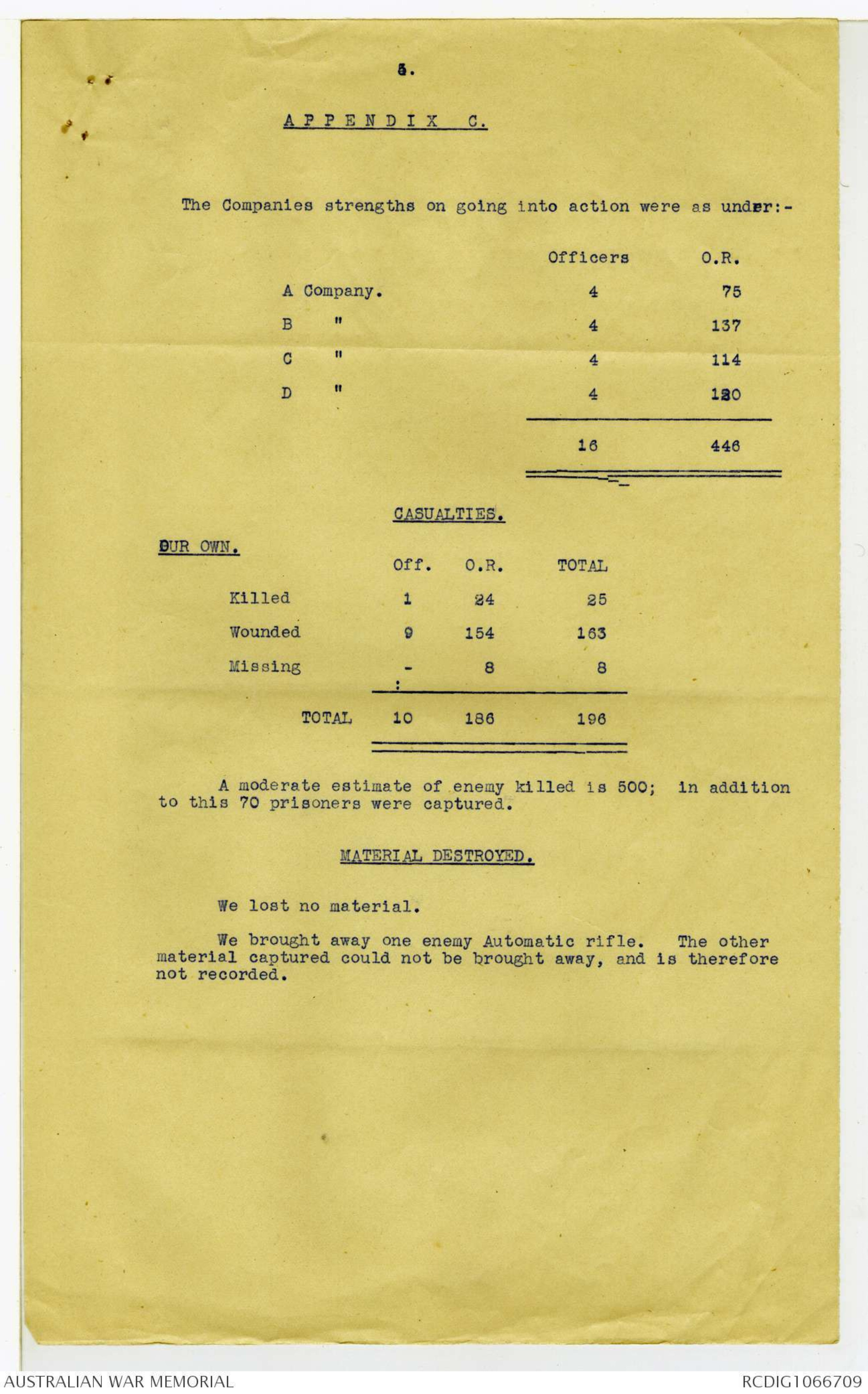
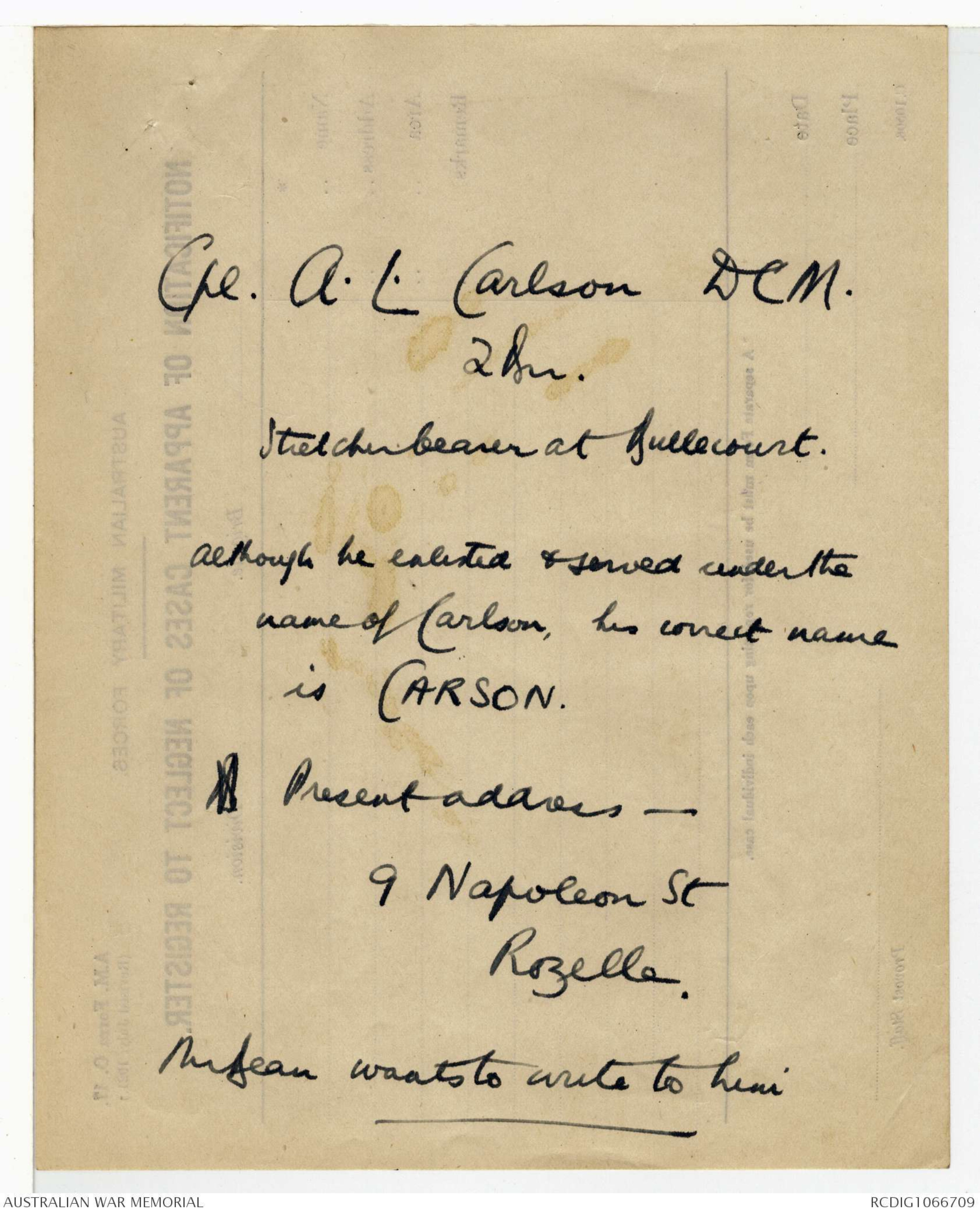
2.
both Battalions and our only communication
was a trench along the road. marked X - - - X
We had previously been in position along railway
embankment A - - - - A.
Both Battalions took over O.G.1 & 2 on the night
of May 3rd 1917. & what was left of the 2nd Div
went out.
The 1st Bn were in O.G.1. in order from right to
left. D. C. A Coys. with B Coy in our original position
in support. I was in charge of D. Coy. & had only
just got my Coy in when there was a flammenwerfer
attack launched on my right post which
was in the trench on the road marked S. We
had just commenced to build a block.
Fortunately I had a number of bombs on me at
the time and was not in their line of fire so
was able to resist their attack the bombs
killing five & putting the flammenwerfer
out of action. See page 4 for balance.
My Coy later relieved A Coy on the left
A Coy taking my place & C Coy ^still in centre.
It was early on May 6th 1917 that while the 2nd
Bn was relieving the 6th that surprised by the Germans enemy who
delivered a strong counter attack from their
3
position in O.G.2. on the right of the 1st BN
marked Y - - - Y. on them. There was no preliminary
fire but just an absolute surprise. evidently
with the intention of capturing the new trench
blocking our communications & eventually
capturing the 1st. & 3rd. BNS.
They in turn got a little surprise fr Cpl C. G. Howell
loaded with bombs & his rifle slung over his shoulder
rushed along the parados of the trench throwing
mills bombs among them till his supply ran out
also Lt Richards (who had previously done good
work on the left) followed with a Lewis gun firing
bursts along the trench. The Germans were so
demoralised that they fled leaving dead &
wounded for this action Cpl Howell was awarded
the V.C. & Lt. Richards on a/c of his work on the
left & in following up the M.C.
The trench was soon reoccupied by the 2nd. BN.
& consolidated.
Simultaneously with the above counter attack being
launched on the right the enemy launched
one at my Coy on the left but were easily
repulsed. We were later relieved by the 4th. BN.
going back to our original position along the
railway embankment.
4
continued from page 2.
That portion of O.G.1 marked B - - - B. was vacated by
the enemy after the failure of their flammenwerfer
attack. They built a block some 50 yds along from
our block which we finished & manned with a
lewis gun. We were not molested again from
this quarter but were very wide awake for it was
our first experience of the flammenwerfer which
scorched the ground & a couple of my men from
what seemed to be a distance of some 20 feet.
How many were actually in the party I cannot
say for they were in O.G.1 & it was very dark
A few bombs were thrown by their party but
with no direction & on being bombed those that
were able soon retired.
I hope I have made this portion of the 1st. BN activities
clear to you but if there is anything further I may
be able to assist you in I shall be only too
pleased to try.
yours faithfully
Rollo Somerset.
Diagram - see original document
Riencourt
REPORT ON OPERATION
AGAINST PORTION OF HINDENBURG LINE BY 2ND. AUST. BATTALION.
REFERENCE MAPS ECOUST-ST.MEIN 1/10000 AND 57C1/20000, N.W.
1. At 0345 on May 3rd. the 2nd. Australian Division, with
certain attached troops, attacked the Hindenburg Line in Squares
U.28, U29, and U.30 with the object of breaking through, seizing
REINCOURT and establishing a line North and East of that village.
The operation was not wholly successful and this necessitated
throwing into the fight the 1st. Australian Infantry Brigade which
was in Reserve.
2. PRELIMINARY MOVES. The 2nd. Australian Battalion at Zero
hour was holding the Corps line of resistance North of BEAUNATRE
from H.6.C. to H.4 Central, and at 0830 was ordered to move from
there to C.19.B, where it would come under the control of the
G.O.C., 7th. Australian Infantry Brigade. Successive positions
were taken up during the day under orders from the 7th., 6th., and
again 7th. Brigade Commanders, and at 2330 the Battalion was in a
defensive position about C.3 Central, disposed to meet a reported
counterattack from BULLECOURT. At that hour orders were received
from 5th. Australian Infantry Brigade to relieve the 18th. Battalion
and elements of other 5th. Brigade Units, and to be prepared to
carry out bombing attacks on the German line by daybreak.. The
time was subsequently postponed.
3. DISTRIBUTION. The relief was carried out, and at daybreak
on the 4th. instant the Battalion was holding the road through
U.29.C. & A. along which a trench had been dug for nearly the
whole length.
Each company held approximately 250 yards facing EAST.
C Company was on the right, then A, D, and B Companys in that
order. Battalion Headquarters at C.5.B.3.7.
By the same time the 3rd. Battalion had relieved elements
of the 6th. Australian Infantry Brigade in O.G.2. from U.23.C.8.0
to U.23.C.0.4. and the 1st. Battalion had taken over O.G.1. from
U.29.A.9.7. to U.23.C.0.0. Outside these limits the O.G. lines
were held by the enemy. A line of posts in C.6.C.& A. and U.30..C
was held by 27th. Battalion.
No other positions were held by us North of the railway
line through C.4.5.2 6.
4. ORDERS. At 1120 the 5th. Australian Infantry Brigade
Operation Memo. No.5 was received. In accordance therewith the
Company Commanders, who had been kept informed of what was likely
to be required so that preliminary arrangements may be made and
bombing parties organised, were assembled at Battalion Headquarters.
The Brigade Operation Memo was read to them, action of T.M. and MGs
explained and verbal orders issued, supported by notes, vide
Appendix B. At 1330 the GOC, 5th. Australian Infantry Brigade, in
telephone conversation instructed me to move into O.G.1 and O.G.2.
until serious opposition was met with when blocks would be established,
the Artillery informed, and the original programme gone on
with.
5. ACTION. In accordance with these instructions Coys. moved
entered O.G.1 and O.G.2. simultaneously at about 1415. Strong
opposition was met with at U.23.D.1.1. where a C.T. entered O.G.2.
After half an hour's fighting this was overcome and a block was
established in C.T. 80 yards North of O.G.2. The Company then
moved on to within 70 yards of C.T. at 3.0.
D Company bombed its way along O.G.1 to a corresponding
position about 70 yards short of 3.7. The C.T. joining these two
points was strongly held and Companys were instructed to establish
blocks until Artillery could be turned on. At 1450 Brigade was
informed of the position and Artillery support asked for. It was
decided that Zero hour should be 1530 as the Artillery could not
open before then, and that the Artillery barrage should commence
on the C.T. from xx 3.0. to 3.7.
2.
At 1540 the Artillery barrage opened and the Infantry again
moved forward. From here onwards normal bombing tactics were
adopted; throwing bombers being relieved as they became tired.
The men were fighting with great dash and were doing great
execution without suffering many casualties.
At 1615 B Company was making such slow progress that C Coy.
went forward before B Company had reached its objective, and
coming in with great dash fresh with great dash carried on.
This completed phase 2.
At 1700 A Company moved through D Company, whom they had been
supporting for sometime, and took the fight on their shoulders.
Both these Companys then carried on till 1900 when they were
within 40 yards of their final objective, where they established
posts
The Coy. in O.G.1. subsequently advanced to C.T. running from
1.6. to 3.7. where they consolidated.
During the whole progress of the fight 4th. Battalion had
been working up road through 29.A. & C. and then along O.G.1. and
O.G.2. At 1715 one platoon had relieved the men holding C.T.
at U.23.D.1.1. and at 1900 remainder of 4th. Battalion had taken
over the trenches allotted to them.
This completed phase 3.
The incessant bomb fighting tired men quickly and the 4th.
Battalion men gradually replaced 2nd. Battalion men in the
fighting end of the trench, the relieved men of the 2nd. Battalion
moving back to 4th. Battalion sector. This gradual exchange was
not completed by midnight when relieving Units of the 3rd. Brigade
began to arrive. The positions gained i.e., O.G.1. to U.30.A.1.6.
and 20.65. and O.G.2. to U.30.A.1.9. were maintained until the
relieving Units took over at about 0200 on the 5th. instant.
6. ACTION OF ENEMY. Reports were constantly received of the
movement of enemy reinforcements down the East and West of
REINCOURT. They assembled in the Sunken roads running N.W. and
S.E. south of REINCOURT and from these delivered their counter
attacks.
His Artillery very quickly got on to the captured trenches
and road through U.29.A. & C. and kept them under continuous and
very heavy shellfire.
Later in the day an extremely heavy barrage was placed at
intervals in the vicinity of C.5.A. & D.
7. ARTILLERY SUPPORT. The rolling Artillery barrage from West
to East was not a success. The fire was not well directed and
for a great part of the distance could not be observed. It was
not sufficiently concentrated in front of our men and individual
guns were slow in moving Eastwards with the result that
casualties were caused. At 1630 our own 18 pounder shells caused
casualties in O.G.1. at 29.B.3.7.
The artillery was extremely useful in meeting and dispersing
counterattacks developing from the direction of REINCOURT.
REINCOURT and its vicinity could be observed from Brigade
Headquarters, and it was from there that the Artillery were directed
and dispersed the massing enemy.
8. TRENCH MORTARS. 1st. A.L.T.M. Battery moved along O.G.1.
and O.G.2. in rear of our advancing bombers and rendered most
valuable assistance. ALL ranks spoke highly of the work done by
the mortars.
9. COMMUNICATIONS. A telephone wire was run up the sunken
road in 29.A. & B. thence Eastwards along O.G.1. and O.G.2. As
progress was made Coys. tapped in and by this means almost
continuos communication was maintained until 1900 when the lines
were so badly cut that further repair was impossible and
communication by runner was the only available means.
Communication to Brigade was maintained by buried cable
until cut, thence by overland route; and with the exception of
about three hours was continuous throughout the operation.
3.
10. SUPPLIES. Supplies of bombs and S.A.A. were taken forward by
Brigade carrying parties and the situation was never acute.
Demands were constantly received from the front line for
rifle grenxades and these could not always be met. There was no
shortage of S.A.A.
It is estimated that 20,000 bombs were expended by the two
Battalions between 1400 and 2400.
11. MISCELLANEOUS. The Mills bomb both hand and rifle again
proved its efficiency. A very large number of Germans were
killed in the trenches and in most cases their bodies were badly
shattered by this most powerful weapon. I am absolutely convinced
of the superiority of our bomb over the German article.
It was difficult to move in O.G.1. without treading on dead
Germans.
It is recommended that for future operations a larger
proportion of rifle to hand bombs should be supplied than we have
hitherto considered necessary. This would involve an increased
issue of cup attachments.
A great number of splendid individual acts of bravery were
performed and I intend to recommend a number for immediate award.
Lieut-Colonel.
Commanding 2nd. Australian Battalion.
4.
APPENDIX B.
NOTES ON BATTALION ORDER FOR OPERATION.
1. TASKS. B Coy. O.G.2 from U.23.C.8.0. to U.23.D.6.0. and C.T.
from U.23.D.6.0. to U.29.B.6.6.
D Coy. O.G.1. from U.29.A.8.7. to U.29.B.6.6. and C.T.
from U.29.B.3.7. to U.23.B.3.0.
C Coy. O.G.2 from U.23.D.6.0. to U.30.A.2.9.
A Coy. O.G.1 from U.29.B.6.6. to U.30.A.1.6. and C.T.
from U.29.B.8.6. to 8.9.
2. SYSTEM. (a) The following system of attack was ordered: -
D and B Coys. will enter O.G.1 and xxxx O.G.2 simultaneously and to
work along close under the artillery barrage.
Posts capable of all-round defences will be established as
progress is made, and grenadiers will be left in xxxx all C.Ts.
Bombing parties will be organised with bombers carriers, Rifle
grenadiers xxxx Bayonet men, with Lewis guns working in close
co-operation.
(b) When D and B Coys. reach their objectives, A and C
Coys will pass through them on the "leap-frog" principle and carry
on.
(c) When A and C Coys. reach their objective, the 4th.
Battalion will take over the trenches occupied by D and B Coys who
will then be available to support A and C.
3. ACTION. The operation was divided into three phases which are
shewn diagrammatcally diagrammatically in the attached sketch.
Appendix A.
5.
APPENDIX C.
The Companies strengths on going into action were as under:-
Officers O.R.
A Company. 4 75
B " 4 137
C " 4 114
D " 4 120
__________________________________________
16 446
___________________________________________
CASUALTIES.
OUR OWN.
Off. O.R. TOTAL
Killed 1 24 25
Wounded 9 154 163
Missing - 8 8
______________________________
TOTAL 10 186 196
________________________________
A moderate estimate of enemy killed is 500; in addition
to this 70 prisoners were captured.
MATERIAL DESTROYED.
We lost no material.
We brought away one enemy Automatic rifle. The other
material captured could not be brought away, and is therefore
not recorded.
Cpl. A.L Carlson DCM.
2 Bn.
Stretcherbearer at Bullecourt.
Although he enlisted & served under the
name of Carlson, his correct name
is CARSON.X Present address-
9 Napoleon St
Rozelle.
Mr Bean wants to write to him
 Deb Parkinson
Deb ParkinsonThis transcription item is now locked to you for editing. To release the lock either Save your changes or Cancel.
This lock will be automatically released after 60 minutes of inactivity.